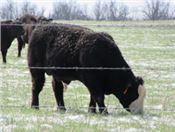|
Buying Bulls 1973 Vs. 2018: All-Breed Bull Sale Oct. 29

Use genomic technology to speed the improvement in your herd.
MT. VERNON, MO.
Another Southwest Missouri All-Breed Bull Sale has been scheduled. This will be the 92nd sale sponsored by the Southwest Missouri Beef Cattle Improvement Association in conjunction with University of Missouri Extension.
The sales begins at 7 p.m. on Oct. 29 at the Springfield Livestock Marketing Center at the west edge of Springfield on I-44.
HISTORY OF ALL BREED SALE
The first all-breed tested sale was held in April, 1973, at Seaton’s Livestock Auction, Nixa. Forty-one bulls sold at that sale and the breed makeup was Charolais, Angus and Polled Hereford. The top price was $1250 for a Charolais, and the average on the 41 head was $898.
“The sale of tested bulls with numbers on them was a fairly new concept in the early 70’s as was an all-breed sale,” said Eldon Cole, field specialist in livestock with University of Missouri Extension.
There were specific performance traits bulls needed to reach to qualify for those early sales according to Cole.
“They had to have a 205-day adjusted weaning weight ratio of 95 percent or better among the male calves in their group. They had to have a 12 or better feeder cattle grade,” said Cole.
At one year of age, sale bulls had to weigh 925 lbs. or more and have a B- or better conformation score. Muscling, freedom from waste, structural soundness and frame were important factors in the MU Extension scoring system.
“We had just begun to measure heights (frame score) in 1973,” said Cole. “Our measuring devices at that time were pretty crude, and the frame scores were mostly assigned by subjective observations.”
The average shoulder height at the sale was 46.7 inches which translated to a 3.5 frame score. The use of hip heights was introduced in 1995.
The sale order index, in the beginning, was based on the bulls’ yearling weight and sale day, subjective grade.
45 YEARS LATER
Forty-five years have passed and tested bull sales continue to have standards bulls must meet to sell. The standards have changed and now involve more science-based information.
Genomic-enhanced expected progeny differences (EPD) is just one category of change that helps bull buyers more accurately assess the genetic merit of their selections.
Bulls in the October 29 sale will have EPDs that rank them in the top-half of their breed for at least three of the following traits: calving ease; weaning weight; yearling weight; milk; marbling score and ribeye area. Also, bulls have a maternal and a terminal index, dollar, and cents value to help your decision-making process.
“Some buyers may be overwhelmed with all the numbers. If that’s the case, give your MU Extension livestock specialist a call ahead of the sale. They will help you sort through the numbers,” said Cole.
EPDs, genomic data, accuracies and indexes can be made understandable.
“Selecting the most genetically correct bull for your herd is helped if you have objective data regarding your herd's genetic makeup and the plan you have for your herd,” said Cole.
SALE INFORMATION
Whether you’re selecting a bull from this sale or another sale or buying semen, the principle is the same, use the number for a faster rate of progress.
Catalogs for the sale are available online at www.swmobcia.com or contact sale manager, Pam Naylor, Buffalo, MO by phone at 417-345-8330. ∆
|
|